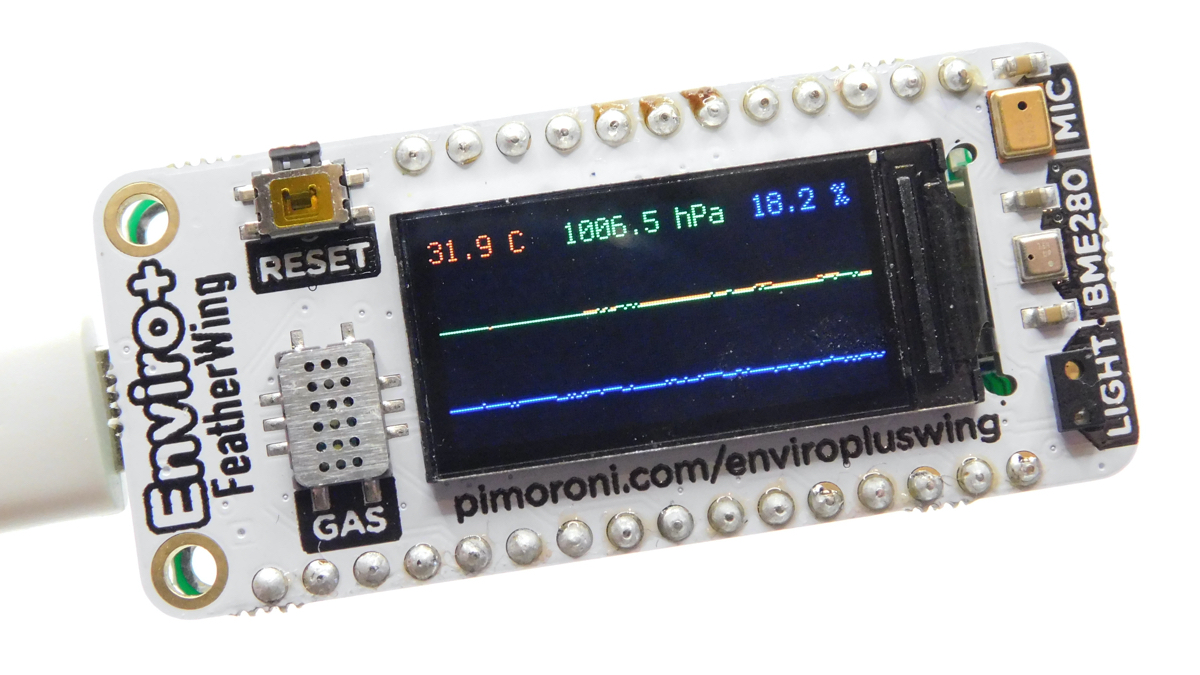
Pimoroni have been making the Enviro + Air Quality for Raspberry Pi for a while – and now they’ve brought the same set of sensors and display to the Feather form factor. This gives you the ability to read temperature, pressure, and humidity via a BME280; light and proximity via an LTR-559; some gases (see below) via a MICS6814, and sound via a MEMS microphone. You can also connect a PMS5003 particulate matter sensor to detect PM2.5 and PM10 pollution (available separately). These are all well-supported sensors, and there’s an accompanying CircuitPython library to get everything working together.
The quality of environmental sensors varies hugely between different models and manufacturers. There are lots of really cheap sensors available which work OK, but can’t really be relied upon for any real accuracy, and there are also hugely expensive scientific instruments that are sometimes needed. These sensors sit somewhere in the middle. They’re good for what they’re intended – monitoring the environment. They’re accurate enough that you can be confident of the readings, but not so costly as to make the board ruinously expensive.
Perhaps the hardest sensor to understand is the gas sensor. It doesn’t measure gases per se, but the properties of the gases in three areas: oxidising (which is typically nitrous dioxide), reducing (which is typically carbon monoxide), and ammonia. All are sensitive to other gasses, so you can’t get an absolute value for the amount of any gas in the atmosphere, but you can use it to get a sense of whether the quality of the air is going up or down.
Of course, reading the sensors is only half the battle; you also need to do something with the data. For this, the Enviro+ FeatherWing comes with a 160×80 display which takes up the majority of the space on the Wing.
The Wing needs a Feather board to work, though not all are supported. Pimoroni recommends the Feather M4 Express or Feather nRF52840 Express. The M0 Express is also listed as working. If you want to get it working with a different Feather, take a look at the physical Feather pins library as you’ll need to get this working on your board.
Heating
We found that the temperature on our board was quite distorted by the heat of the electronics. The effect of this will be different depending on the particular Feather you use, as they’ll all have different thermal properties. On the nRF52840 Sense at least, ours was reading about five degrees hotter than the ambient temperature, but changes to the code could probably decrease this.
Connected with a Feather, you can display any (or all) of the sensor values on the screen. The example code comes with a plotter that shows how the readings change over time. The screen is only 0.96 inches, but the resolution is high enough that you can display quite a bit of data.
The board itself has no connectivity, so if you want to read the data wirelessly, you’ll need that either on the Feather you use (the nRF52840 has BLE), or as an additional FeatherWing. Since FeatherWings stack, you should be able to add WiFi or LoRa via the appropriate Wing should you need it. Similarly, no additional IOs are broken out, so if you want to add more sensors, you’ll either need to carefully select which headers you connect, or break them out using a Wing multiplexer.

Taking flight
The Feather ecosystem is a great fit for a device like this. It’s small, easy to use, and there’s a great range of boards to expand it with the capabilities you need. Perhaps the most curious thing about the Feather ecosystem is why there hasn’t been a good environmental sensor Wing before. The Enviro+ FeatherWing rights that wrong.
The example CircuitPython code shows you how to get data out of all the sensors with just a couple of lines of code – it all worked flawlessly for us. If you simply want to read data and show it on the screen, you probably won’t need any more than the example code. However, if you want to send it somewhere (either via Bluetooth to a phone using an nRF52840 Feather or over some other network using additional Wings), you should find it easy to adapt the code to do what you need.
Pimoroni £45 shop.pimoroni.com
VERDICT
Air quality should be important to all of us, and this helps us understand it.
9/10





